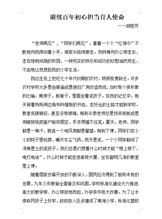初中英语状语从句详细解析
状语从句是英语语法中的常用句型语法,那么大家是否清楚什么是状语从句呢?下面就是小阅给大家带来的初中英语状语从句详细解析,希望能帮助到大家!
状语从句详细解析
一、什么是状语、状语从句?
状语:是用来修饰动词、形容词、副词或全句用的。
eg:He works hard! (他努力工作)中的hard。
状语的位置:
修饰形容词或副词的状语放在被修饰语之前。
eg:The Summer Palace is very beautiful.颐和园非常美丽。
(very 为状语,修饰形容词 beautiful,放在 beautiful 之前)。
修饰动词的状语有的放在动词前,有的放在动词之后。
如果动词有宾语,状语一般须放在宾语之后。
eg: I He often came here to see me.他经常到这里来看我。(often 为状语,修饰动词came,放在前面)。
I know him well.我十分了解他。(well为状语,修饰动词 know,放在 know 之后)。
状语从句:用一个句子(从句)来作另一个句子(主句)的状语,用作状语的句子就叫作状语从句。作什么样的状语就叫什么类型的状语从句。例如:条件状语从句就是用一个句子来作条件状语。
二、状语从句的分类。
(1)时间状语从句
凡是从句都必须有引导词,引导时间状语从句的词有when,before,after,until,as soon as,while 等,具体用法如下:
1. when 意为“当……时”,引导时间状语从句,表示主句的动作和从句的动作同时或先后发生。
eg: I feel very happy when you come to see me.
When you are crossing the street,you must be careful.
when引导的时间状语从句,when的从句可以用延续性动词,也可以用瞬间动词。
eg:He was working at the table when I went in. 。
Someone knocked at the door when I was sleeping.
I will visit my good friend when I have time.
注:when也可以作并列连词,表示一个动词正在进行的时候,突然间发生了另外一件事。
eg: I was fishing by the river,when someone called for help.
We were working in the chemistry lab,when the lights went out.
2. before 意为“在……之前”,引导时间状语从句时,表示主句的动作发生在从句的动作之前。 eg: We cleaned the classroom before we left school yesterday.
He had been a cook before he went to college .
after 意为“在……之后”,引导时间状语从句时,表示主句的动作发生在从句的动作之后。
eg: After you use plastic bags,you mustn't throw them about.
He called me after he had finished his work.
注:若主句和从句两个动作发生的先后顺序十分接近,那么也可以不用完成时态,如上面的 第二句可改成:He called me after he finished his work.
3. since引导的时间状语从句,译为“自从……”,主句常用现在完成时,从句常用一般过去时。
eg: I have taught English, since I came to Shenzhen.
注:常用句型:It is +时间段+since从句 译为:自从……有多长时间了。
eg. It is six years since she graduated from the university.
4. until 意为“直到……时”,引导时间状语从句时,表示主句的动作发生在从句的动作之前。
当主句的谓语动词是持续性动词时,主句常用肯定形式;当主句的谓语动词是非持续性动词时,从句常用否定形式,not…until… 意为“直到……才……”,这时的until可以用before 来替换。
eg:I'll stay here until you come back.
我会呆在这里,直到你回来。 (stay表示的 动作可以持续)
He didn't go to bed until he finished his homework.
他直到做完作业才睡觉。(go to bed 表示的动作不能持续)
5. as soon as 意为“一……就……”,表示从句的动作一发生,主句的动作马上就发生。
eg:I'll tell him about it as soon as he comes back.
6. while引导的时间状语从句,常译为“与……同时,在……期间”,while的从句中常用延续性动词或表示状态的词。
eg. They rushed in while we were discussing problems.
Father was cleaning the car while I was playing computer games.
注:while也可以作并列连词,表转折的关系,相当于but,译为“然而”。
eg. I like listening to music,while my brother likes doing sports.
7. till和until引导的时间状语从句,译为“直到……为止”,not … till / until引导的时间状语从句,译为“直到……才”。前者强调主句动作的结束,用延续性动词,后者强调主句动作的开始,用瞬间动词。
eg. I will wait for my friend until / till he comes. 我要一直等到我朋友来。
We won't start our discussion until / till he comes.
我们要等到他来了,再开始我们的讨论。
(2)条件状语从句
1.条件状语从句通常由if, unless引导。
eg:What shall we do if it snows tomorrow?
Don’t leave the building unless I tell you to.
2.在条件状语从句里,谓语动词通常用现在时态表示将来的动作或状态。(主将从现)
eg:I’ll help you with your English if I am free tomorrow.
He won’t be late unless he is ill.
3.“祈使句 + and (or)+ 陈述句” 在意思上相当于一个带有条件状语从句的复合句。
eg:Hurry up, or you’ll be late.=If you don’t hurry up, you’ll be late.
Study hard and you will pass the exam.
=If you study hard, you will pass the exam.
(3) 原因状语从句
1.原因状语从句通常由because, since, as引导。
eg:He didn’t come to school because he was ill.
As it is raining, we shall not go the zoo.
Since you can’t answer the question, I’ll ask someone else.
2. because表示直接原因,语气最强。Because引导的原因状语从句多放在主句之后。回答由why提出的问题,只能用because。As和since语气较弱,一般用来表示明显的原因。由as和since引导的原因状语从居多放在句首。
eg:------Why aren’t going there? ------Because I don’t want to.
As he has no car, he can’t get there easily.
3. because和so不能同用在一个句子里。
For 语气最弱,它所引导的分句必须放主句后面,引补充说明作用。
eg:Put on more clothes, for it's cold outside.
注:because, since, as, for 的区别
语气 位置 意义
because 最强 前或后 “原因”;表客观因果关系;回答“”
as 较强 前 “由于”;把众人所知的事实当作理由
since 较弱 前 “既然”;就对方陈述的事实作为理由
for 最弱 后 “理由”;对某一事实进行推断的理由
(4)地点状语从句
常用where(哪里)和wherever(无论哪里)
eg. Where there is a will,there is a way. 有志者,事竟成。
We will go wherever the motherland need us most. 我们要到祖国最需要的地方去。





